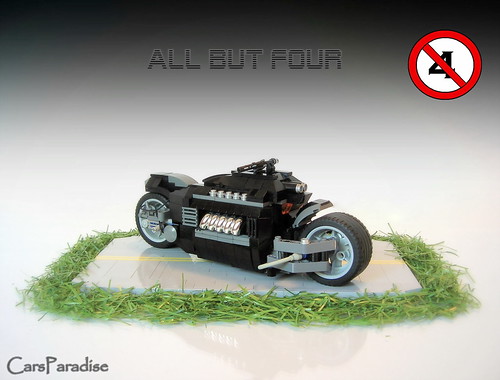Prolific teen builder Jordan Schwartz agreed to do an interview for us here at Brickspace, so here it is:
>To start off, could you tell us a little about yourself?
 As many builders online know, my real name is Jordan Schwartz. I've been building since I was three, and I've been active in the online community since I was thirteen (I am currently sixteen years of age.) I am not a member of any LUGs, nay have I attended any LEGO convention, so nobody really knows much about Jordan the person, but my MOCs tell a lot about Jordan the builder. LEGO is my only true hobby; having dabbled in other non-bricky mediums before, I know this is where I belong. I do have a few other interests; I enjoy reading when I get the time (though I rarely have the time), I am a passionate conservative libertarian, and I love collecting taxidermy (which gets me pounched on every time I post a picture of my animals on flickr!) I also keep a pet Jenday Conure named Autumn, who can't get enough of LEGO - her element of choice is the 2 x 4 brick; nibbling at the tube-and-coupling system is a lot of fun for her! In addition to my flickr, MOCpages and Brickshelf galleries, I have an official website that can be viewed at brickstud.com.
As many builders online know, my real name is Jordan Schwartz. I've been building since I was three, and I've been active in the online community since I was thirteen (I am currently sixteen years of age.) I am not a member of any LUGs, nay have I attended any LEGO convention, so nobody really knows much about Jordan the person, but my MOCs tell a lot about Jordan the builder. LEGO is my only true hobby; having dabbled in other non-bricky mediums before, I know this is where I belong. I do have a few other interests; I enjoy reading when I get the time (though I rarely have the time), I am a passionate conservative libertarian, and I love collecting taxidermy (which gets me pounched on every time I post a picture of my animals on flickr!) I also keep a pet Jenday Conure named Autumn, who can't get enough of LEGO - her element of choice is the 2 x 4 brick; nibbling at the tube-and-coupling system is a lot of fun for her! In addition to my flickr, MOCpages and Brickshelf galleries, I have an official website that can be viewed at brickstud.com.>Can you blame us? They're dead animals! But moving on, are there any builders that influenced (or still influence) you when you began to develop your style?
Well, I'm not sure I'd say I've got much of a "style", with the exception of my delicate connections! But certainly there are many builders that have subliminally influenced me over the past two years or so. Certainly some that stand out are Legohaulic, Nannan, Moko, Michael Jasper, RebelRock, and pretty much everyone over at Builders Lounge. I feel very fortunate to have been able to be a part of that community when I was early in my LEGO building "career", and I totally attribute my quality to them. And because I build in just about every theme, there are plenty of other influential builders out there that have affected me as a builder.
>That brings me to my next point. It seems almost like you make it your business to build in every theme possible- are you simply not interested enough to stick to one theme, or are you too interested in everything else?
I think it's fair to say a little of both. I'd get very bored if I built, say, space ships all day, but I've also got an interest in many other themes, which works out well for me. Also, sometimes I'll build something simply if I have a good minifigure or technique for the theme, which also keeps my MOC collection diverse. It's safe to say I'm usually partial to historical MOCs, but even that has a million and one sub-themes under it (from pirates to Victorian.) But like I said - it all works out well in the end.
>You've impressed a lot of people (myself included) with how prolific you are. Your flickr photostream contains over one and a half thousand photos, all taken within about a year and a half. The majority of those may be single minifigures built to demonstrate a single technique, but you still put out full models much faster than most other builders. Are you devoting a huge amount of time to the hobby, or do you just find that you can turn a concept in your head into a finished model very quickly?
Thanks very much! Again, I think it's a little of both. I do devote a ton of time into the hobby (most of my free time, in fact), but at the same time, if I'm motivated and enthusiastic about a project, I can finish it quickly. But enthusiasm really is the key to prolificness - if I lose interest in a project, it'll take forever to finish it seems, or I don't finish it at all. The perfect example is my Fun House.
>But with that attention comes a cost. Your prolificness, and in particular, your tendency to build a lot of things with mass appeal tends to draw a lot of less-informed comments from the younger LEGO fans out there. How have you dealt with that?
 Well, first I'd like to say that the more LEGO fans out there, the better. We have all had to start somewhere, right? But yes, there seems to have been a tidal wave of spam within the past few months. I haven't done too much about it; every now and again I'll delete a comment or two, and unfortunately I have had to block a couple users (the first time in about two years!) but it's truly getting to a point where it is intolerable. Sometimes people might say that I don't take negative feedback well if it is their comment I delete, but that's not true, as long as it is constructive. That seems to be a problem as of late - comments like "I don't like this", or "It is weak." Alright, that's your opinon, but we all know what opinons are like (well, maybe those younger fans don't know that expression.) Provide some constructive feedback - I tend to appreciate that kind more than wholly positive feedback because more time is put into it.
Well, first I'd like to say that the more LEGO fans out there, the better. We have all had to start somewhere, right? But yes, there seems to have been a tidal wave of spam within the past few months. I haven't done too much about it; every now and again I'll delete a comment or two, and unfortunately I have had to block a couple users (the first time in about two years!) but it's truly getting to a point where it is intolerable. Sometimes people might say that I don't take negative feedback well if it is their comment I delete, but that's not true, as long as it is constructive. That seems to be a problem as of late - comments like "I don't like this", or "It is weak." Alright, that's your opinon, but we all know what opinons are like (well, maybe those younger fans don't know that expression.) Provide some constructive feedback - I tend to appreciate that kind more than wholly positive feedback because more time is put into it.>Well, then, to wrap up, do you have any advice for new builders?
For all the new builders out there, you simply have to keep building. If you look at my last flickr page and compare it to my current, first one you will notice a night and day difference. If you truly enjoy it, just keep at it because with every single creation, you will get better and better; that's a fact that has been perfectly illustrated by today's top builders.












.png)
